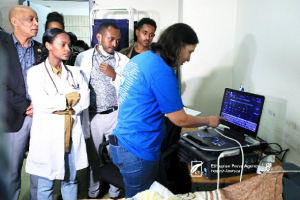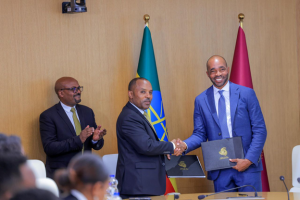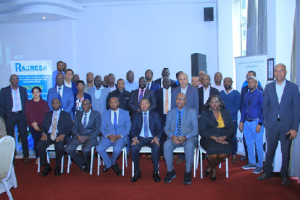
Ethiopia has completed the installation of the 433 kilometers of Ethio-Kenya power transmission line. The high voltage electric highway, a joint project of the two countries which covers 1,955 km with a capacity of carrying up to 2,000 megawatts, is yet another testimony to Ethiopia’s unwavering commitment to regional economic integration.
According to the Ethiopian Electric Power, some 433 km of the total transmission line lies in Ethiopian border. The installation of the substation has also reached 88 percent and is expected to be completed by November 2019.
It is also reported that following the completion of the necessary preconditions, the power transmission will start based on the agreement of the two countries.
True, repeatedly, Ethiopia has demonstrated a strong commitment to play a leading role in stabilizing the turbulent Horn Africa. Not only that, but the country has also been the major proponent of regional economic integration. While the country is currently in transition, it is actively involving in regional issues, reaffirming its commitment to the regional cause.
Before and after Prime Minister Abiy came to power, Ethiopia has been showing a strong commitment to a regional issue. Since coming to office, regional peace and stability have remained at the top of Prime Minister Abiy Ahmed’s priority list. As it is tradition, he once again reaffirmed that Ethiopia will continue its efforts to pacify and economically integrate the Horn of Africa in a manner that benefits the people of the region.
Abiy said that neighbors that engage in intimate rule-based trade and economic integrations are unlikely to resort to conflicts. “That is why we believe integration must be viewed not just as an economic project but also as crucial element to securing peace and reconciliation in the Horn of Africa.”
This is one of the major reasons why the country has reached several agreements with its neighbors to jointly expand infrastructural development such as railways, roads, power connectivity, and port development.
In the past couple of years, it has been witnessed that the country prepares its development projects by taking the peoples of the Horn Africa and beyond into consideration. This is particularly true for the country’s energy projects. For instance, if we take the Grand Ethiopian Renaissance Dam, besides meeting the rising energy demand of Ethiopia, it is also planned portion of the power generated from the Dam would be exported to neighboring countries and also Egypt.
Besides, Ethiopia is currently exporting electricity to several neighboring countries. It has also planned to export electricity to North Africa, South Africa and the Middle East in the future.
The country aspires that its economic gains would contribute hugely in expediting the attainment of regional economic integration in the Horn of Africa. That is why the government of Ethiopia has spent about 333 million USD for the construction of the transmission line and the substation.
The Ethiopian-Kenya power highway project has the capacity of interconnecting East African countries with electricity as the highway is constructed with the capacity of carrying up to 2,000 MW. There is a possibility to transmit the power Tanzania, Uganda, and other countries in the long run after Ethiopia completes its power generating megaprojects. When completed and goes operational, this would be yet another milestone in achieving the lofty goal of achieving regional economic integration in the Horn.
The Ethiopian Herald, August 15/2019





